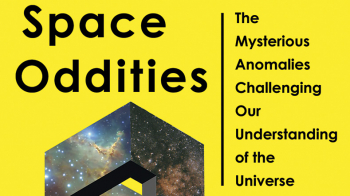Engaging with the abstract world of theoretical physics, artists find new inspiration. In return, scientists can see their own research in a new light. Iliana Tatsi and Mónica Bello describe the interdisciplinary journey behind the stunning installations in CERN Science Gateway.

Within the naturally lit expanse of the Exploring the Unknown exhibition at CERN Science Gateway, an artwork both intrigues and challenges: Julius von Bismarck’s Round About Four Dimensions, commonly referred to as the “tesseract”. As light interacts with its surfaces, the tesseract – a 3D representation of a 4D cube – unfolds and refolds, turning inside out in a hypnotic sequence that draws viewers into its rhythm (see “Round About Four Dimensions” image). This kinetic piece not only captivates with movement but also signifies the deep-rooted relationship between art and science.
Organised around themes of space and time, dark matter, and the quantum vacuum, the Exploring the Unknown exhibition becomes a meeting point, inviting spectators to dive into the collective curiosity of both artists and scientists. In particular it channels the imaginative spirit of CERN’s theoretical physicists, including Joachim Kopp, who remarked during an encounter with a visiting artist: “I try to visualise the maths. So, whenever I work on something, I need to have some pictures in my head, even when it’s mathematical concepts.” This sentiment illuminates the profound visual connection artists and scientists alike experience when confronted with complex ideas.
Rich dialogue
Born from the collaborative efforts between the Arts at CERN programme and the CERN exhibitions section, this display vividly encapsulates the synergy between art and science. By championing artist residencies, commissioning distinct art pieces and curating exhibitions, a rich dialogue is fostered between two seemingly distinct worlds. For the first time, Science Gateway will spotlight works born from residencies and commissions, proudly featuring creations from celebrated resident artists including Yunchul Kim, Chloé Delarue, Ryoji Ikeda and Julius von Bismarck.

Within CERN’s corridors, serendipitous dialogues emerge. An artist might gain fresh inspiration from a casual chat about the universe, looking at their work through a new lens. On the other hand, physicists can discover a fresh perspective on their familiar theories through the artist’s interpretation. As former CERN theorist Tevong You insightfully shared during one such discussion, “In the quantum world of particles and waves, there’s a beauty that artists instinctively grasp. They bring to life the equations we scribble on paper.”

The dialogue between diverse minds takes centre-stage at Science Gateway. Yunchul Kim harnesses the intricacies of fluid dynamics (see “Chroma VII” image), capturing space and time and the elusive nature of dark matter in his sculptures. Chloé Delarue crafts tangible experiences around the mystery and the uncertainty of the unknown (see “TAFAA” image), while the avant-garde audiovisual installations of Ryoji Ikeda breathe life into the elusive quantum vacuum (see “data.gram [n°4]” image). As artists immerse in these scientific domains, they unearth fresh inspiration and, in return, challenge scientists to see their own work through a different prism. This unconventional collaboration amplifies both fields: artists distill vast, abstract concepts into evocative forms, and scientists, inspired by this artistic partnership, discover enriched avenues through which to communicate their research.
Navigating the confluence of art and science is no straightforward journey. For every moment of synergy, there are hurdles to clear – terminology gaps, differing methodologies and the occasional skepticism from both sides. However, through the many interactions we’ve experienced between scientists and artists, it’s clear that these challenges can be overcome. Artists, through their residencies at CERN, have cultivated an understanding of complex scientific narratives. Conversely, CERN scientists have come to appreciate the evocative power of art, expanding beyond their traditional vocabulary. This endeavour is about building bridges, recognising the need for compromise, and ultimately celebrating the beauty that emerges when diverse worlds collide.
![data.gram [n°4]](https://cerncourier.com/wp-content/uploads/2023/10/CCNovDec23_BEAUTIFUL_datagram2-635x137.jpg)
Finding equilibrium between artistic liberty and scientific truthfulness is also a delicate dance. In the vast realm of creativity, an artist might sometimes venture far from the core scientific concepts in their pursuit of artistic expression. In Exploring the Unknown, such balances are impressively maintained by von Bismarck’s tesseract and Ikeda’s audiovisual installation data.gram [n°4]. The exhibition shows that neither art’s freedom nor science’s precision need to be sacrificed; when approached with mutual respect, they can coexist, each enhancing the other’s message.








